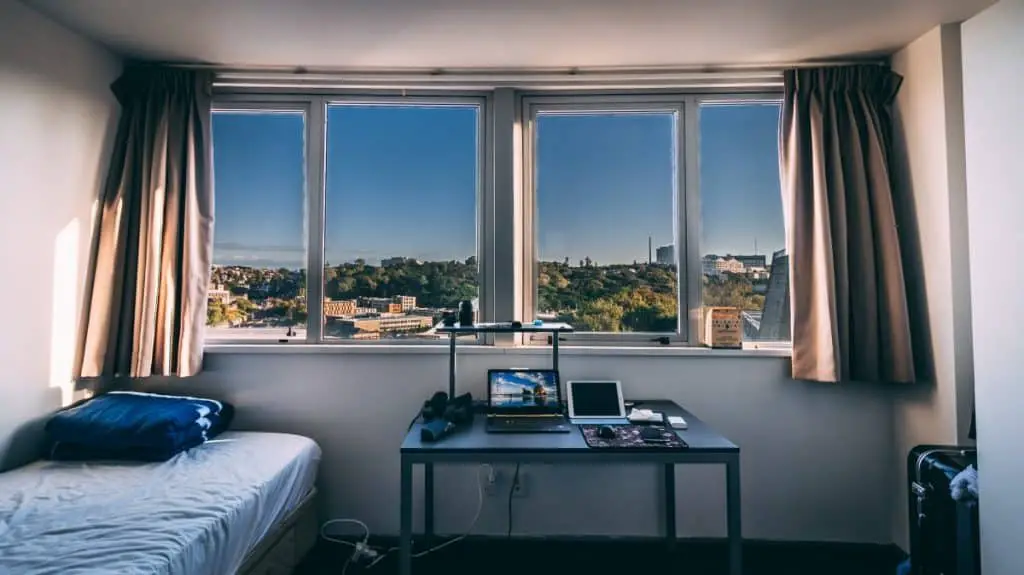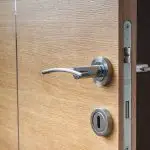
Soundproofing Your Dorm Room – Easy and Inexpensive
How to soundproof your dorm room? If you’re a college student living in a dorm, this may be a top concern of yours, especially after move-in is complete, and you find out how noisy your dorm room actually is. In this post, I’ll share with you some simple and quick tips on how you can soundproof your dorm room.
I can still remember my days as a college student. I was exactly in the same situation. The sound and chatter outside my dorm room were so loud, making every studying hour difficult. I could hear all the noise from my fellow students talking and laughing next door. Exam week was especially difficult for me. Dorm rooms the world over are notorious for being very busy – and loud.
Back then, I had no idea that I could do something to soundproof my college dorm room. But during my senior year, I started seeking ways to soundproof my own room. The only problem was that not all those techniques were applicable due to the college’s dorm rules.
Fortunately, I found some simple yet effective soundproofing techniques that are compliant with the dorm rules. In this post, I’ll share those techniques with you. I hope this helps.
First, set realistic expectations for “soundproofing” your dorm room
First, in case you don’t already know, there’s a big difference between “sound proofing” and “sound dampening”, or sound isolation. Soundproofing a room means to make it such that sound cannot enter or leave the room. That’s a tall order, and you certainly won’t achieve that in just about any room outside of a recording studio. Sound dampening – limiting the sound that enters your room, is a much more reasonable goal – and easily and inexpensively accomplished. We’ll still use the word “soundproof”, since it’s what everyone uses, even when they mean “sound dampening”.
A word of warning about soundproofing in general, in a place that you don’t own: you can’t make permanent alterations to floors, ceilings, or walls. And, if you do stick things to the wall, make sure you do so with something that doesn’t damage the wall, when you remove it. Command Strips are the perfect solution to hanging soundproofing panels and other soundproofing materials to dorm walls. Every incoming student should pack some.
OK, so how do we soundproof your dorm room?
As mentioned, there are a number of simple things you can do to dampen the noise coming into your room. Here are some easy and effective techniques.
1. Adding a Thick Area Rug to the Floor
Most dorm rooms have a conventional floor with tiles or other hard floors. The problem with this is that sound is louder in rooms with solid surfaces. Hard surfaces reflect sound, while soft surfaces absorb sound. Think about your high school hallways – hard surfaces all around, and boy, does the sound bounce around! The good news is that there are simple things you can do to minimize the noise.
One of the simplest solutions for this problem is to add materials that will help trap the sound and prevent it from bouncing off. Adding a rug is what I found the quickest way to somehow reduce the sound. A rug like the one shown here will absorb the sound and dampen it making your dorm room quieter than ever. The thicker the rug, the better, but really any rug will cut down on the noise quite a bit. In fact, even if your dorm room is already carpeted, tossing a thick shaggy rug on top will substantially improved the sound absorption.
If you’re living on the second floor of the college dorm, applying rugs may not only minimize noise coming into your dorm room, but also keep your neighbors below from being disturbed. The rugs will absorb your footsteps, conversation, and of course, your music.
If the rug shown above looks a little too dressy, consider these casual, sound-absorbing rug alternatives:
Moroccan Ogee Trellis 2-inch Thick Area Rug
Plush Sheepskin Throw Round Rug
2. Hang Sound Absorbing Decorations on the Walls
Another quick and easy technique you can use is to hang decorations on your walls, especially those that contain soundproofing materials. Strategic placement of pictures on the wall could help to dampen the sound. In my college days, wall hangings were all the rage. They’re pretty much out of style now, but any soft materials on the wall can help – including prints on canvas (notably, without glass).
There are actually companies that make sound-absorbing art panels, specifically for this purpose, like the one on the right. The manufacturer says that the soundproof padding built into this (cool) artwork actually absorbs sound 10 times better than acoustic foam panels.
At the cheaper end of the cost spectrum for sound-absorbing materials are egg cartons and Styrofoam. Although these may be more suitable to the average college student’s budget, they are certainly not as attractive, nor are they as effective at cutting down on the noise.
3. Add Furniture with Sound-Absorbing Textures
Aside from decorations, putting furniture in the room can also make a difference. Of course, your dorm room probably already has a bed, and probably a wooden desk, chair and cabinets. The mattress helps absorb sound a lot, but the wooden furniture doesn’t help hardly at all. Topping your chairs with soft pillows and cushions, and tossing a fluffy comforter on the bed will significantly improve the sound absorption. You can also add a bookshelf filled with books. You might think this is odd, but bookshelves are great in dampening sound. They have lots of irregular surfaces, which deflect sound nicely, and of course, paper itself is a good sound absorber.
However, you don’t need to clutter your room with unnecessary stuff. So be wise and creative.
Is additional furniture too expensive for your budget? Check out your local thrift store – virtually every college town has one.
4. Put Curtains on the Window
Windows are some of the most difficult parts of the room when it comes to soundproofing. They’re hard surfaces, so transmit sound from the outside, and even bounce back sound inside. Unfortunately, windows are challenging to soundproof. But if you really want to soundproof a college dorm, you need to take windows into consideration.
One of the most effective ways to soundproof a window is to hang thicker window coverings. Soundproofing curtains have enough density to block out or absorb the sound. The curtains shown here are super heavy-duty, lined blackout curtains. They’re designed to block out sound, and as a bonus, also block out light.
Another good thing about soundproof curtains is that they don’t just soundproof the room, but also add the aesthetic value of the room.
5. Fill Up all the Gaps in the Room
Any room will be soundproofed well if all the spaces are filled up. However, placing furniture in the room alone will not completely fill the spaces.
You many not think of plants as sound absorbing, but they can definitely help as well (we’re talking planters here, not cacti in a pot). How about a coat rack? Those hanging jackets and coats can absorb a lot of sound. Also, adding a gaming chair can help, too. Remember – any soft surface will absorb sound.
6. Hang a Cork Board
If you prefer poster art to canvas prints, you could add another popular student must-have, a corkboard. Corkboards are very useful to post notes and reminders, photos, schedules, etc. Cork is super sound absorbent, and so are most of the things you’d stick to them!
7. Use a White Noise Machine
Well, you might be thinking that a white noise generator has nothing to do with soundproofing. However, a white noise machine will really help to cancel out disturbing outside noise.
This classic white noise machine actually produces a nice, soothing “whoosh” sound that will cover up the outside noise. All you’ll be hearing is the soothing sound from the machine. (We’ve had one in our bedroom for many years.)
Technically, you are using noise to eliminate noise here. If there’s no other way you can soundproof your dorm room using the techniques I shared above, then buying a noise machine can be your best option. Even if you do get sufficient noise reduction using the other methods we discussed, the white noise adds another level of sound insulation to your room.
If you prefer nature sounds, rather than the simple white noise, you have many options as well, including the Adaptive Sound Technologies Sleep Sound Machine. This sound machine contains hundreds of environmental and nature sounds, including ocean waves, slapping water, babbling brooks, a waterfall, pouring rain, birds, frogs, whales, and many more relaxing sounds. Not only do these sounds block out other unwanted sounds, these nature sounds are very calming even in general.
Final Thoughts On How to Soundproof Your College Dorm
Living in a college dorm room can have several challenges. The most common problem is noise, especially if the rooms are not sound insulated. Of course, these sounds cause problems when you’re reviewing your lessons or trying to get some sleep.
Fortunately, there are many ways you to lessen the disturbing outside noise. All of these techniques, alone or in any combination, will help soundproof your college dorm room.
Happy successful soundproofing!
To learn more about soundproofing, feel free to visit my soundproofing guide.
Related Questions:
How to Deal with Noisy Neighbors in College?
Unfortunately, there’s not much you can do to this situation. You cannot simply control other people.
However, there are some strategies you can implement to somehow lessen the outside noise. The following are good examples:
- Close the door and place a thick curtain on it. This is not the ultimate solution but will certainly help.
- Turn on an electric fan. This is not about canceling noise but creating another breed of noise. It is a good way to cancel the outside noise and only hear the background noise.
- Play your favorite music through your headphones. I tried this one before and it worked especially when listening to classical music.
- Buy a noise-canceling earplug. This will help you gain your focus while studying.







